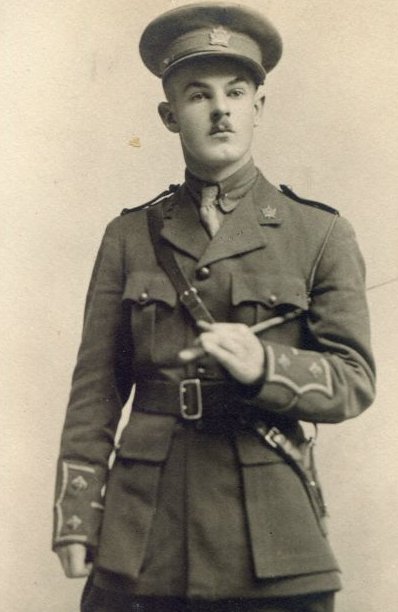ADVANCE [newspaper]: My earliest recollection of it was that it was run by a man named Marchant – his wife was a sister of Maurice Smith’s wife, The shop was across the railroad track in what we know as the Mumford Block, now owned by Arch Kerr. There were three little places in the bottom; barber shop in one end, Town Office in the middle, and the Customs Office in the far end. Overhead was the Advance office. After Marchant, a man named George Woodworth took it over and ran it till it died. It was there for a while, then moved [to] a little building from T. R. Johnston property over to where Karl Dowe’s house is now. His office was there, and he built on to it two or three times. Later it was moved up the Lane and it burned down.
Tri-Mu Church Club started by Methodist minister, then taken over by the Baptist minister. It was a church group but open to all boys. The clubroom was above McKinnon’s present store (old basketball hall), or they met at the minister’s house. It ended about the time of the first World War after Rev. Machum left. It got its name from Mr. Barrett and its motto from Timothy 2 – 2:15
Parrsboro and Falmouth belonged to two lumber companies, Parrsboro Lumber Company and S. P. Benjamin. The S. P. was on the West Branch of the Avon River and the Parrsboro Lumber on South Branch. Their little tow boats had hinged smoke stacks so they could be tipped down when they went up under bridges at high tide (under the railroad bridge). They brought lumber down on scows to Hantsport or anchored off Hantsport, or even off Blue Beach where the water was deeper. Barques used to anchor down there where there was more water. The lumber was anything from lathes to heavy timber. Those tow boats only hauled lumber scows.
Chester belonged to the Gypsum Company, the predecessor to U. S. Gypsum. She took barges from Blue Beach to Wentworth, loaded them there and then towed them back down. Then a big towboat would come up from New York and take about three of these scows at a time to N.Y.
Later on they built one called J. A. Mumford after the U.S. Gypsum took over.
Captain Billy McKinley had a little boat (he used to do some towing) called Evelyn. It carried water to schooners. Had a forward hold planked tight inside as a water tank. He took water out to schooners anchored in the stream off Hantsport. It was named for his daughter, Mrs. John Trenholm. The next one was called the Hilma. He did different towing – gravel from Parrsboro shore, pulp from there. He had two or three scows.
After the Hilma was lost to fire on the Parrsboro shore, he built the Louise M, named after another daughter, Mrs. C. Van Buskirk. Another tow boat, before my time, was the Acadia.
Mr. Otis Wack was in charge of operations. The J. A. Mumford was named for the man who owned the Mumford Block. His sister was married to J. B. King of the J. B. King and Company, the predecessor of U. S. Gypsum. Mumford was an engineer boiler maker. He had a little boiler shop here. He left to go with Robbs’ Engineering, Amherst, and made what was called the Robb-Mumford boiler.
The foundry was the big building later used by the Hantsport Fruit Basket. It was closed up after it was taken over by the Murrays.
The rink was in this building after it was closed and before the Murrays. The outdoor rink was where the railroad goes in to the Gypsum building. There was a rink – Parker’s Rink – where the Murray office was. It was outdoor, and burned down; then used the old foundry moulding shop which was long enough – it had an ell out towards Veniot’s, all one long building. (See G. M.)
One who swam the Avon was Harold Hart. He used to wear a boater hat. He would swim awhile, turn over on his back, take the boater off and in it was his pipe, tobacco and matches. He’d light up, then put the stuff back in the hat, put his hat back on his head and swim around. He’d be floating on his back while he smoked.
Bill Murray lived up in Mrs. Sim Harvie’s house. His older brother was a captain of a three-mast Schooner called Advance. Bill had a withered arm; hard to credit that he could swim the river. When tide gets near full there’s not too much current, then for a slight spell there’s none at all, then the tide turns. On high run of tides, the current is much stronger and the period of slack water less.
My Grandfather lived in the house where Merrill Hyson lives. My father [George Comstock] was born in 1863 and when 14, moved to Prince St. Grandfather was a blacksmith and had his shop down near where the big shed is near Murray’s house. He had a lot of help, seven or eight men; had to board them and the house wasn’t big enough. Some were apprentices, some full time. They were from away and he had to board them. He bought a house on Prince Street, the other side of Regan Apartments, which had 15 to 16 rooms and was big enough.
I was born in Barney Langille’s house. My father was a piano tuner, carpenter, Town Clerk for a while, Mayor for a while. He went to the States, attended Boston Conservatory of Music for a time. He learned the piano business from the bottom up – worked in a piano factory and tuned pianos. He played in the Baptist Church for a few years before he went away.

